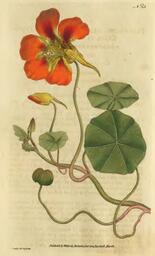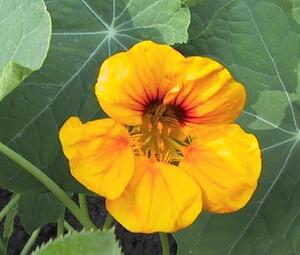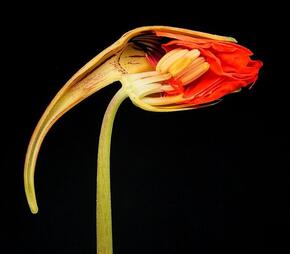Nasturtium - Tropaeolum Majus
Latin Name - Tropaeolum Majus known as well as Garden Nasturtium, Indian Cress or Monks Cress It's a perennial climber, or can be also herbaceous annual plant. In some documents its menioned as Flowering Ground Covers(for Plant Guild)
Physical Characteristics
“…the garden NASTURTIUM tolerates most soils, though it prefers a rich light well-drained soil in full sun or partial shade. More and lusher leaves are produced when the plant is growing in a rich soil, though less flowers are produced. When grown in a soil of low fertility the leaves are smaller and less lush, though more flowers are produced. Plants will often maintain themselves by self-sowing, though in cold springs the seed will often not germinate until mid or even late summer, which is too late to produce a reasonable crop. A very ornamental and free-flowering species, it is often in bloom from early summer until cut down by the autumn frosts. There are many named varieties, ranging from vigorous climbing forms to low-growing dwarf forms. The flowers have a hot, watercress-like flavour and make a tasty addition to the salad bowl. T. minus is a closely related species with the same uses.” http://www.pfaf.org/leaflets/flowers.php
History Nasturtiums are native to South America. They were brought to Spain in the 1500's. Introduced into Europe by the Spanish, they became popular and grew in the royal gardens of France and later in America at Thomas Jefferson's Virginia home, Monetcello. The genus name comes from the Latin ~Nasus tortus~ meaning ~convulsed nose~ referring to the ~faces people made when tasting the spicy plant. http://www.angelfire.com/journal2/flowers/n.html
Edible Uses
Edible Parts: Flowers; Leaves; Seed; Seedpod
“Leaves - raw. A hot watercress flavour. Very nice on its own or as a flavouring in mixed salads. Rich in vitamin C. The leaves are available from early summer until the first frosts of the autumn. Flowers - raw. A very ornamental and tasty addition to the salad bowl, the flowers have a hot watercress flavour and are available all through the summer. The flowers contain about 130mg vitamin C per 100g. Young seed pods - raw. These are even hotter than the flowers or leaves. They can also be harvested whilst immature and pickled for use as a caper substitute. Seed - raw or cooked. Very hot. The mature seed can be ground into a powder and used as a pepper substitute. The seed contains 26% protein and 10% oil.” http://www.pfaf.org/database/plants.php?Tropaeolum+majus
“How To Make Nasturtium Sandwiches”, you can find here: http://chestofbooks.com/food/recipes/Cook-County/How-To-Make-Nasturtium-Sandwiches.html
“How To Make Nasturtium Seeds Used As Capers”: http://chestofbooks.com/food/recipes/South-Africa/How-To-Make-Nasturtium-Seeds-Used-As-Capers.html
and “…Wash the buds and seeds thoroughly, and steep overnight in a brine of ½ cup kosher or pickling salt to a quart of distilled water. (The salt dissolves more rapidly if the water is warmed on the stove, but allow it to return to room temperature before brining the pickles.) Drain buds and seeds, and place in a clean glass jar. Boil sufficient white or white wine vinegar to cover, and pour into jar. Seal and process for ten minutes, or refrigerate immediately and use within two weeks…” from: Green Hell/http://mygreenhell.typepad.com/my_weblog/2009/11/incredible-edibles-garden-nasturtium.html
Medicinal Uses
“Nasturtium has long been used in Andean herbal medicine as a disinfectant and wound-healing herb, and as an expectorant to relieve chest conditions. All parts of the plant appear to be antibiotic and an infusion of the leaves can be used to increase resistance to bacterial infections and to clear nasal and bronchial catarrh. The remedy seems to both reduce catarrh formation and stimulate the clearing and coughing up of phlegm. The leaves are antibacterial, antifungal, antiseptic, aperient, depurative, diuretic, emmenagogue, expectorant, laxative and stimulant. Extracts from the plant have anticancer activity. The plant is taken internally in the treatment of genito-urinary diseases, respiratory infections, scurvy and poor skin and hair conditions[238]. Externally it makes an effective antiseptic wash and is used in the treatment of baldness, minor injuries and skin eruptions. Any part of the plant can be used, it is harvested during the growing season and used fresh.” http://www.pfaf.org/database/plants.php?Tropaeolum+majus
Other Uses Insecticide/ Oil/ Repellent
The seeds yield a high percentage of a drying oil that can be used in making paints, varnish etc. The growing plant attracts aphids away from other plants. Research indicates that aphids flying over plants with orange or yellow flowers do not stop, nor do they prey on plants growing next to or above the flowers. An insecticide can be made from an infusion of leaves and soap flakes. http://www.pfaf.org/database/plants.php?Tropaeolum+majus
Companion to garden
Widely grown as companion plants, nasturtiums are one of the gardener's best friends because they fend off garden pests from neighboring plants. Grow them near squash to help repel cucumber beetles, and they will also help keep away many different kinds of aphids. Though they do attract one species of aphid, the black aphid, you can use this to your advantage. If black aphids are a problem, grow nasturtiums to keep aphids from destroying other plants. Then when the nasturtiums are covered in aphids, pull those plants up and destroy them, aphids and all. http://findarticles.com/p/articles/mi_m1082/is_4_43/ai_55439570/
Myths and Tales



